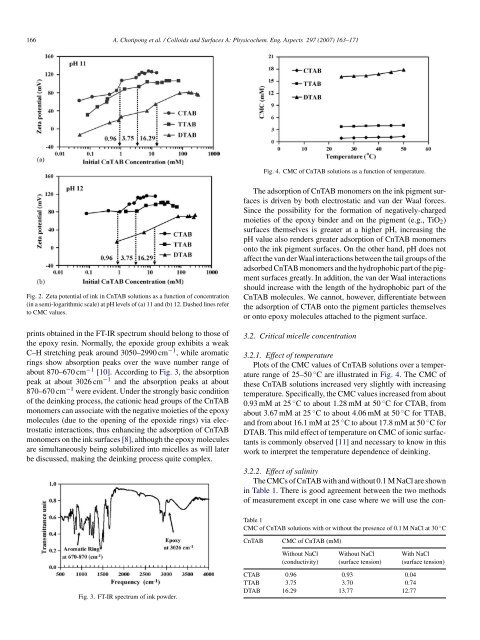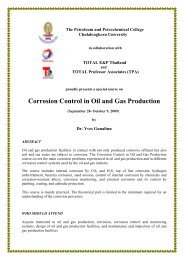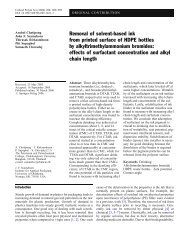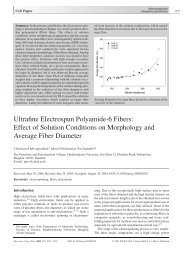Removal of solvent-based ink from printed surface - The Petroleum ...
Removal of solvent-based ink from printed surface - The Petroleum ...
Removal of solvent-based ink from printed surface - The Petroleum ...
You also want an ePaper? Increase the reach of your titles
YUMPU automatically turns print PDFs into web optimized ePapers that Google loves.
166 A. Chotipong et al. / Colloids and Surfaces A: Physicochem. Eng. Aspects 297 (2007) 163–171<br />
Fig. 2. Zeta potential <strong>of</strong> <strong>ink</strong> in CnTAB solutions as a function <strong>of</strong> concentration<br />
(in a semi-logarithmic scale) at pH levels <strong>of</strong> (a) 11 and (b) 12. Dashed lines refer<br />
to CMC values.<br />
prints obtained in the FT-IR spectrum should belong to those <strong>of</strong><br />
the epoxy resin. Normally, the epoxide group exhibits a weak<br />
C–H stretching peak around 3050–2990 cm −1 , while aromatic<br />
rings show absorption peaks over the wave number range <strong>of</strong><br />
about 870–670 cm −1 [10]. According to Fig. 3, the absorption<br />
peak at about 3026 cm −1 and the absorption peaks at about<br />
870–670 cm −1 were evident. Under the strongly basic condition<br />
<strong>of</strong> the de<strong>ink</strong>ing process, the cationic head groups <strong>of</strong> the CnTAB<br />
monomers can associate with the negative moieties <strong>of</strong> the epoxy<br />
molecules (due to the opening <strong>of</strong> the epoxide rings) via electrostatic<br />
interactions, thus enhancing the adsorption <strong>of</strong> CnTAB<br />
monomers on the <strong>ink</strong> <strong>surface</strong>s [8], although the epoxy molecules<br />
are simultaneously being solubilized into micelles as will later<br />
be discussed, making the de<strong>ink</strong>ing process quite complex.<br />
Fig. 3. FT-IR spectrum <strong>of</strong> <strong>ink</strong> powder.<br />
Fig. 4. CMC <strong>of</strong> CnTAB solutions as a function <strong>of</strong> temperature.<br />
<strong>The</strong> adsorption <strong>of</strong> CnTAB monomers on the <strong>ink</strong> pigment <strong>surface</strong>s<br />
is driven by both electrostatic and van der Waal forces.<br />
Since the possibility for the formation <strong>of</strong> negatively-charged<br />
moieties <strong>of</strong> the epoxy binder and on the pigment (e.g., TiO2)<br />
<strong>surface</strong>s themselves is greater at a higher pH, increasing the<br />
pH value also renders greater adsorption <strong>of</strong> CnTAB monomers<br />
onto the <strong>ink</strong> pigment <strong>surface</strong>s. On the other hand, pH does not<br />
affect the van der Waal interactions between the tail groups <strong>of</strong> the<br />
adsorbed CnTAB monomers and the hydrophobic part <strong>of</strong> the pigment<br />
<strong>surface</strong>s greatly. In addition, the van der Waal interactions<br />
should increase with the length <strong>of</strong> the hydrophobic part <strong>of</strong> the<br />
CnTAB molecules. We cannot, however, differentiate between<br />
the adsorption <strong>of</strong> CTAB onto the pigment particles themselves<br />
or onto epoxy molecules attached to the pigment <strong>surface</strong>.<br />
3.2. Critical micelle concentration<br />
3.2.1. Effect <strong>of</strong> temperature<br />
Plots <strong>of</strong> the CMC values <strong>of</strong> CnTAB solutions over a temperature<br />
range <strong>of</strong> 25–50 ◦ C are illustrated in Fig. 4. <strong>The</strong> CMC <strong>of</strong><br />
these CnTAB solutions increased very slightly with increasing<br />
temperature. Specifically, the CMC values increased <strong>from</strong> about<br />
0.93 mM at 25 ◦ C to about 1.28 mM at 50 ◦ C for CTAB, <strong>from</strong><br />
about 3.67 mM at 25 ◦ C to about 4.06 mM at 50 ◦ C for TTAB,<br />
and <strong>from</strong> about 16.1 mM at 25 ◦ C to about 17.8 mM at 50 ◦ C for<br />
DTAB. This mild effect <strong>of</strong> temperature on CMC <strong>of</strong> ionic surfactants<br />
is commonly observed [11] and necessary to know in this<br />
work to interpret the temperature dependence <strong>of</strong> de<strong>ink</strong>ing.<br />
3.2.2. Effect <strong>of</strong> salinity<br />
<strong>The</strong> CMCs <strong>of</strong> CnTAB with and without 0.1 M NaCl are shown<br />
in Table 1. <strong>The</strong>re is good agreement between the two methods<br />
<strong>of</strong> measurement except in one case where we will use the con-<br />
Table 1<br />
CMC <strong>of</strong> CnTAB solutions with or without the presence <strong>of</strong> 0.1 M NaCl at 30 ◦ C<br />
CnTAB CMC <strong>of</strong> CnTAB (mM)<br />
Without NaCl<br />
(conductivity)<br />
Without NaCl<br />
(<strong>surface</strong> tension)<br />
CTAB 0.96 0.93 0.04<br />
TTAB 3.75 3.70 0.74<br />
DTAB 16.29 13.77 12.77<br />
With NaCl<br />
(<strong>surface</strong> tension)





